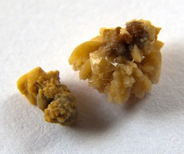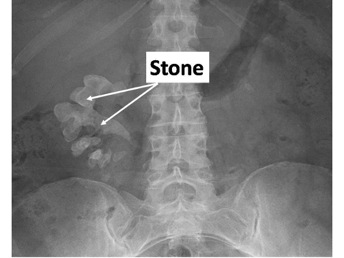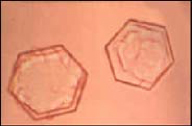Kidney Stones

Are all stones the same?
No, there are four main types of kidney stones.
- Calcium containing stones (75%)
- Uric acid stones (10%).
- Infection stones, called struvite 10%
- Cystine stones. These form from cystine due to an inherited genetic abnormality and are rare.
Why do stones form?
Stones form because of crystallisation. If we think back to school science then crystals grow because the solution becomes too saturated with the chemicals (solutes) that make up the crystal. The solubility of a given crystal can be different depending on the pH of the urine (that is how acidic or alkaline it is), and whether inhibitors of crystallisation are present. A common inhibitor is citrate. This stops stones forming even if there is too much dissolved stone chemicals in the urine. Making your urine as dilute as possible by drinking lots of fluid is the single best way (and hardest) to stop stones forming.
Occasionally stones form because of other causes, such as a problem with a small gland in your body called the hyper-parathyroid. This causes the blood level of calcium to be too high.
Do all stones need to be treated?
No many stones sit in the kidney and do no harm. They may not grow for many years and they may not move. With modern x-rays, especially CT scans very tiny stones can be seen that do not need to be treated and are too small to treat.
Can I dissolve stones that have formed?
The only stones that can be easily dissolved are Uric acid stones. Cystine stones can be dissolved slowly if the urine is very alkaline. All other stones once formed are insoluble. Uric acid stones are more soluble if the urine is more alkaline, dilute and if less uric acid is being made. So to dissolve uric acid stones you should take a drug called allopurinol, which stops uric acid being made, drink more water and alkalinise the urine with bicarbonate of soda. This can be taken as baking soda or Ural sachets or potassium citrate. If we increase the pH from 6 to 7 then there is a 10-fold increase in solubility and if we reach a pH of 8 then a 100-x increase in solubility will take place.
You should aim for a urine pH of between 7 and 8, but not more. This can be measured with pool pH sticks. Remember Alkaline turns red litmus paper blue. You are aiming for light green colour.
How can I have my stones treated?
There are different treatments for different sized stones and also for where the stone is. If the stone is in the ureter then usually we use telescopes to reach the stone. If the stone is in the kidney then the standard treatments are
- To look into the kidney with a small telescope and laser the stone. This is called ureteroscopy. (link to other talk)
- To break the stone up with shock waves (ESWL)
- To puncture the kidney from outside and look into eth kidney with a telescope (PCNL).
If the stones are easy to see on a plain film then ESWL can be used to break the stones up. This uses shock waves form outside the body to break the stone up. The fragments then are passed over the next few weeks.
If the stone is very large then an operation where a telescope is put through the back into the kidney is used. This is called percutaneous nephrolithotomy or PCNL.
How can I stop stones forming again?
This depends on the stone type so each stone will be discussed in turn in a little more detail.
Calcium stones:
Calcium stones form usually from calcium and oxalate. Calcium and phosphate is much rarer.
- Drink more fluid
- Reduce salt intake – Salt is swapped for calcium in your kidney. So more salt in equals more calcium in urine.
- Take lemon juice. 1 teaspoon a day.
- Reduce protein intake – Protein causes acids to leach calcium from your bones. This calcium is the peed out, increasing the amount in the urine.
- Change your diet slightly. Try and reduce oxalate intake, but paradoxically maintain your calcium intake.
- Avoid green leafy vegetables
- Avoid nuts
- Avoid chocolate
- If stone formation is persistent take potassium citrate.
Lemon juice helps keep crystals dissolved.
Salt in the urine is swapped for calcium. This leads to more calcium in your urine. So always try and reduce salt intake
Uric acid stones.
- Take allopurinol.
- Keep urine alkaline.
- Take potassium citrate if you cannot get urine alkaline enough
Infection Stones (Struvite).
Special bacteria form Struvite stones. The bacteria produce a chemical (carbonic anhydrase), which makes stones form. The bacteria then live within the stone formed. The stone means it is difficult to get rid of the bacteria with antibiotics. This means that for most people with struvite stones surgery is needed to get rid of all the stone, and then you need 6 weeks of antibiotics after surgery to eradicate any traces of the bacteria.

An x-ray showing a large staghorn calculus in the right kidney
Struvite stones often cause a very large stone called a staghorn to be made. Luckily this often only happens in one kidney. Staghorn calculi can often fill the entire kidney and can lead to the kidney dying if not treated.
Cystine.
Cystine stones are rare and form in patients with an inherited metabolic disorder, which causes too much cystine to be excreted in the urine. Cystine is much more soluble in alkaline urine. The best way to reduce cystine stone formation is to make the urine as dilute as possible, alkalinise urine and sometimes take medication.
- High fluid intake
- Potassium citrate with a target urine pH of 7.5-8
- D-penicillamine

If lemon juice is good should I take vitamin C?
No, lemon juice contains citrate, which stops stones forming. Vitamin C is converted to oxalate once eaten and this increases the risk of stone formation.
Is there any difference between Ural and Potassium Citrate?
Yes, Ural is sodium citrate and potassium citrate mixed together. The citrate is good for you. Unfortunately the sodium is not and as discussed above more sodium (salt) leads to more calcium in the urine. Potassium citrate increases the citrate levels without the salt levels going up and is therefore more likely to stop stones forming.
Where can I get more information?
For stones in general:
http://www.aafp.org/afp/1999/1115/p2269.html
http://www.medicinenet.com/kidney_stone_pictures_slideshow/article.html
For diet please see:
http://www.ncbi.nlm.nih.gov/pmc/articles/PMC1455427/pdf/20060509s00011p1407.pdf
For Uric acid stones:
http://www.ncbi.nlm.nih.gov/pmc/articles/PMC1831527/pdf/RIU009001_0017.pdf
For cystine:
http://www.cystinuria.com.
http://www.cystinuria.com/articles/treatment-of-cystine-stones/
http://www.ncbi.nlm.nih.gov/pmc/articles/PMC2653923/pdf/799.pdf
